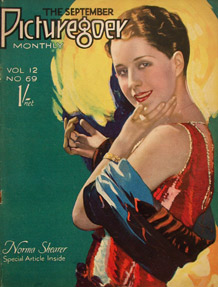
Front cover of the Picturegoer
100 Years of cinema fan magazines
The first fan magazine for film enthusiasts in Britain was published 100 years ago this week.
The British Picture Publishing Company released the very first issue of The Pictures, a small, sixteen page illustrated story paper on 21st October 1911.
The University of Exeter’s museum of moving image history, The Bill Douglas Centre (BDC) holds the first ever British film fan magazine in its extensive collection spanning the history of cinema. As well as being a great source of information about films, fan magazines also demonstrate how society has changed and how ordinary people have sought glamour and excitement in their lives.
The Pictures carried stories based on newly released films, copiously illustrated with photographs from the productions. In its opening editorial they claimed that ‘Our Stories will make the picture actors real and living personages’. The Pictures promised to be ‘all brimful of interest, all thrilling’ and ‘the quintessence of sensationalism’.
‘The Pictures’ magazine marked the birth of a rich 100 year history of film magazine publishing. Fan magazines became a significant part of film culture across the early teens and into the 1920s, where they developed from fiction papers to highly popular star magazines. This provided audiences with gossip about the movie stars, new productions, screen fashions and competitions, fuelling the growth of early celebrity media. Fan magazines were a valuable tool for the film industry, enabling them to advertise new productions and to address an ever expanding audience that it increasingly recognised as predominantly female.
Dr Lisa Stead, who’s PhD at Exeter focused on the fan magazine said: “As women came to constitute the majority of cinemagoers, 1920s titles such as Picturegoer (the successor of The Pictures) and Picture Show became an essential item for anyone interested wanting intimate details about the glamorous female performers they watched on screen. The fan magazine had a unique advantage in this respect in the silent era. It was able to supply coveted information to its readers about the eye, hair colour and speaking voices of their otherwise silent, black and white screen idols.
She added, “These magazines were advertising tools not just for the film industry, but for a wide range of products and companies that wanted to communicate with the same audience of female consumers who spent their money at ‘the pictures’.”
The content of the Picturegoer magazine across the twenties, thirties and forties feature a tremendous amount of advertising vying for the attention of female readers, according to Dr Stead’s research. Amidst film gossip and beautifully rendered star portraits are a multitude of illustrated adverts promoting new household appliances, star-endorsed cosmetics, soap powder and dress-patterns.
Dr Stead found that when perusing these magazines across their early history, perhaps the most striking aspect is the beauty of their cover art. Early Pictures covers tended to display a singular still image from one of its fictionalised films; and during the 1920s covers frequently featured full colour artwork paintings of leading stars. Picturegoer covers depicted famous British film stars like Betty Balfour in February 1924 and Carmel Myers amidst the branches of painted cherry blossoms on the April 1926 cover.
The advent of television in the 1950s saw a dramatic reduction in the cinema audience, with its female fans shifting to viewing at home. Picturegoer finally ended in 1961 and fan magazines started to shift to a new emerging audience of regular cinemagoers – teenage boys and young men. This group remains the core cinema audience today and contemporary British film magazines like Empire and Total Film reflect this. Instead of beauty products, their adverts concentrate on trainers and gadgets, and coverage of films is often centred on action spectaculars and special effects wizardry.
The fan magazines can be been seen firsthand at the BDC, the University’s museum of moving images. It is a unique experience that takes the reader back into time, imagining their appeal to generations of readers, cinemagoers and film enthusiasts. The BDC also has digitised versions of the illustrated magazine covers which are available via the online catalogue. www.exeter.ac.uk/bdc
Date: 20 October 2011
